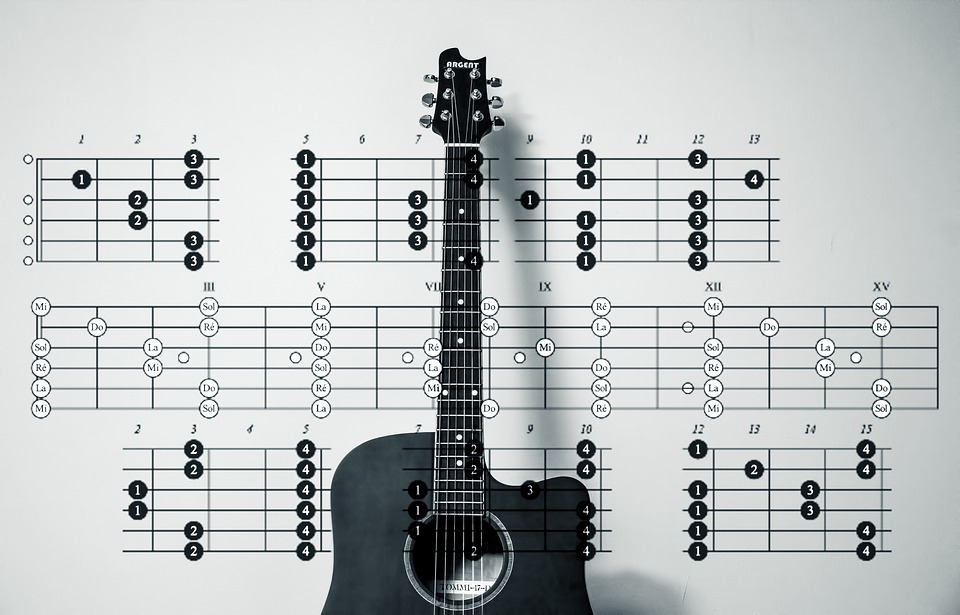First up is a skill that’s highly undervalued by guitarists themselves but very sought-after in a guitarist by other musicians: rhythm guitar. If you plan to do any part or full-time playing, you’ll find that most of the time you’ll be playing rhythm guitar rather than soloing. Guitarists that focus on soloing, scales and whatnot will have huge gaps in their knowledge such as chords, timing, strumming, and even how to create a rhythm part.
1. Essential Rhythm Skills
There are a number of approaches you can take to learning rhythm guitar. I find students usually fall into one (or both) of two categories; they either need to improve their strumming technique, or their strumming technique is good, they just need a more chord-based approach to rhythm guitar.
Technique
If you feel you need both of these skills, then start with strumming technique. Here are a couple of great resources you could use:
Strumming for the Curious Guitarist is a great course by guitar teacher Dan Dresnok that covers pretty much everything you need to know about strumming, and more importantly, how to count! Dan is a solid, no-frills guitar teacher who explains and demonstrates things very well. Basically, it feels like you’d showed up at his house and got a great lesson, only in the digital medium, you get an entire course for the price of one lesson. Check out the course here.
If you’re in your first year or so of playing, or aren’t looking for something quite as in-depth, check out 12 Strumming Patterns You Must Know for Guitar by Henry Olsen, which does exactly as the title suggests and teaches you 12 really useful rhythm patterns in around an hour.
Theory
If you’ve already gotten your strumming skills down and want to improve your rhythm playing, you probably need to check out the chordal/theory side of things. I can honestly tell you that learning random chords and progressions won’t work to a great extent here; in fact, these are actually better for improving your strumming technique. The best approach to expand your knowledge, in my opinion, is to really get your triads down. Triads, when paired with rhythm playing, will unlock the neck for you and allow you to not only create rhythm parts, but understand how they work. You’ll see how to move between chords in the space of a few frets, embellish chord progressions and be able to form any chord off the top of your head. The course you can use to get this done is Michael Palmisano’s Leave the CAGED System Behind, which is not advertised as a rhythm guitar course, but does include this essential chord/theory knowledge. Part 2 has also just come out.
2. Ear Training
Next up is Ear Training, which is something that every musician needs to do throughout their playing career. Guitarists are notorious for avoiding ear training because the ability to use patterns on the guitar somewhat undermines it. If you don’t believe me, try out the exercise in this lesson. Ear Training doesn’t have to be a painful process and I’m a huge fan of two resources for improving your musical ear. The first is Alain Benbassat’s (free) app Functional Ear Trainer (Android | iPhone), which, unlike most ear training apps, is based on cadences and learning to hear intervals in context rather than guessing random pairs of notes because if you want to work something out by ear, 99% of the time it will be in the context of a piece of music.
The second is another course by Dan Dresnok called Ear Training for the Curious Guitarist, which gives you the complete guide to developing relative pitch and working with intervals, and complements what you’ll be practicing in the Functional Ear Trainer app.
3. Music Theory
Last but by no means least is music theory. This is another area where guitarists are at the bottom of the pile due to relying on shapes or learning about theory through guitar-based methods such as the CAGED System. While there’s nothing wrong with this, guitar-based methods tend to complicate things when communicating with musicians that play other instruments, as these theories and methods don’t apply to them. What I’d recommend is a more universal music theory course such as Rajiv Narang’s The Elements of Music | Music Theory and Foundations, which covers everything you need to know about music theory without making it overwhelming.
So, if you feel stuck in a rut, or want to get serious about becoming an all-round musician, a serious study of these three areas will sky-rocket your abilities and set you in good stead for a career in music.



